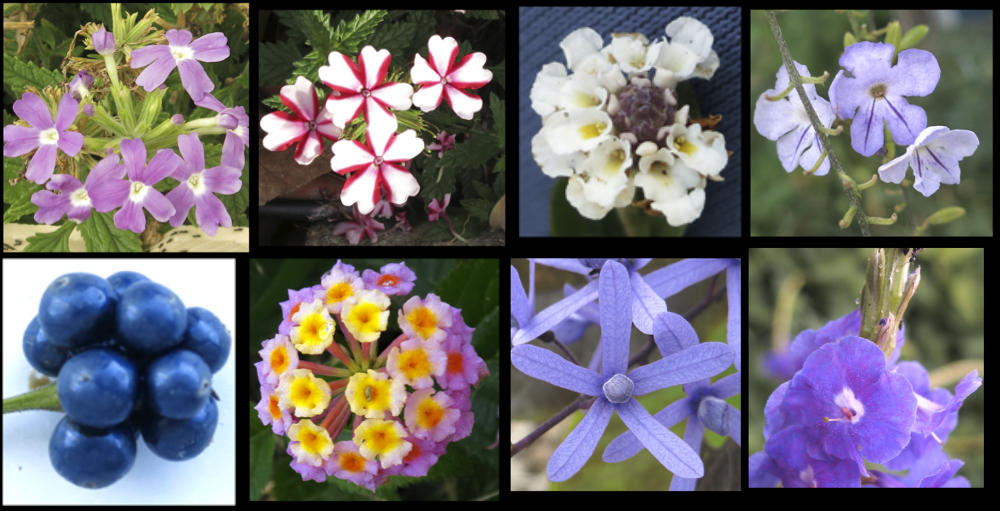Verbenaceae.
Members of the Verbena family are mostly from South American.
The old, loosely defined Verbenaceae s.l. had 75 to 100 genera with 2600 to 3020 species.
Many of these had similarities to the Lamiaceae such as bilabiate corollas and the calyx persisting in the fruit.
There were also similarities with other families such as Acanthaceae, Boraginaceae and Oleaceae.
A number of genera such as Callicarpa, Clerodendrum, Holmskioldia, Karomia and Rotheca were moved to
Lamiaceae and a few went to the other families.
Now the more strictly defined Verbenaceae s.s. has around 34 (31 – 35) genera and 1175 (918 – 1200) species.
Some of the better known genera are Citharexylum, Duranta, Glandularia, Lantana, Petrea, Stachytarpheta and Verbena.
Australia has 15 species in 3 genera.
Most are herbs with some shrubs (sometimes scrambling), trees and a few twining vines.
The stem is often square, sometimes only when young.
There is often a ridge across the leaf nodes.
Plants are often aromatic.
The leaves are typically opposite and decussate, rarely whorled or alternate.
They may be directly attached (sessile) or have a petiole.
They are usually simple but some are compound (ternate, palmate or pinnate).
Others are dissected and some are lobed.
The edges usually have teeth (serrated).
Inflorescences can be elongated spikes (cymes or racemes), panicles or a head.
Some have coloured involucral bracts.
(Cymes are branched inflorescences with the terminal flower opening first; racemes are branched spikes
with the stalked flowers opening at the bottom first.
Heads are dense clusters of flowers with or without stalks.
An involucre is a whorl of bracts at the base of a flower or a cluster of flowers.)
Almost all are bisexual and have they parts in 4’s or 5’s.
There may be an annular hypogynous disc.
There are 5 (4 – 8) basally joined sepals in the tubular or bell-shaped calyx.
The top of the tube can be flat or have lobes that are often unequal but not bilabiate.
The bases of the 5 (4) petals form a corolla tube.
The lobes are typically unequal and sometimes form 2 lips with various numbers of lobes in each.
There are (2) 4 (5) stamens that insert at any level into the corolla tube.
Up to 3 stamens may be reduced to staminodes.
The stamens, almost always of 2 different lengths, usually do not extend past the corolla.
The dorsifixed anthers open inwards via longitudinal slits.
The superior ovary usually has 2 carpels but false septa often make 4 or more locules.
In a few genera there are 4 or 5 carpels.
Each of the 2 true locules has 2 ovules mostly with basal or axile placentation.
Secondary locules have 1 ovule.
The single style is typically apical or occasionally in a slight apical depression or lateral.
The stigma can be simple or bilobed.
It may appear swollen due to glandular tissue.
The fruit are schizocarps with nutlets or drupelets, or occasionally a capsule.
The calyx persists and encloses the fruit.
J.F.


